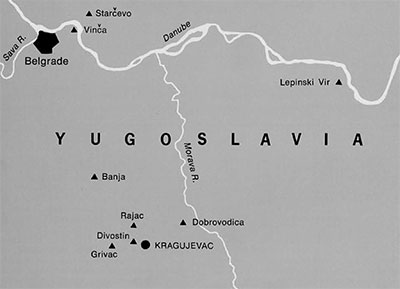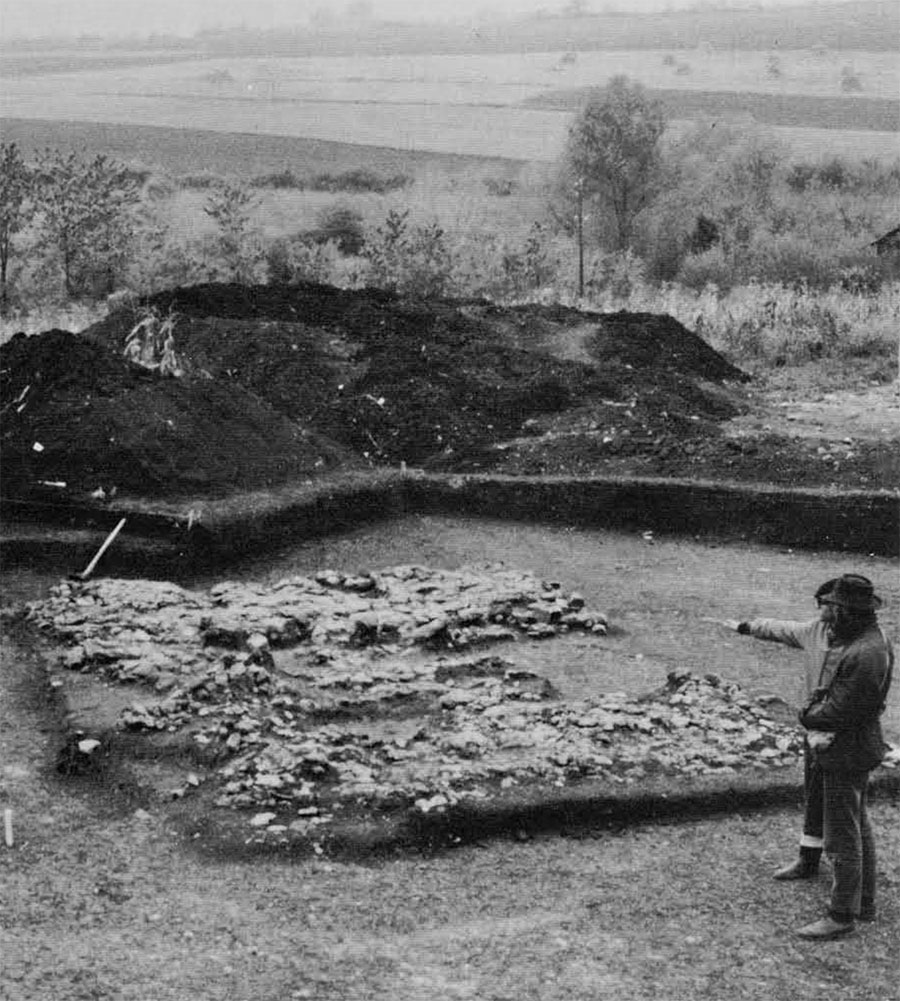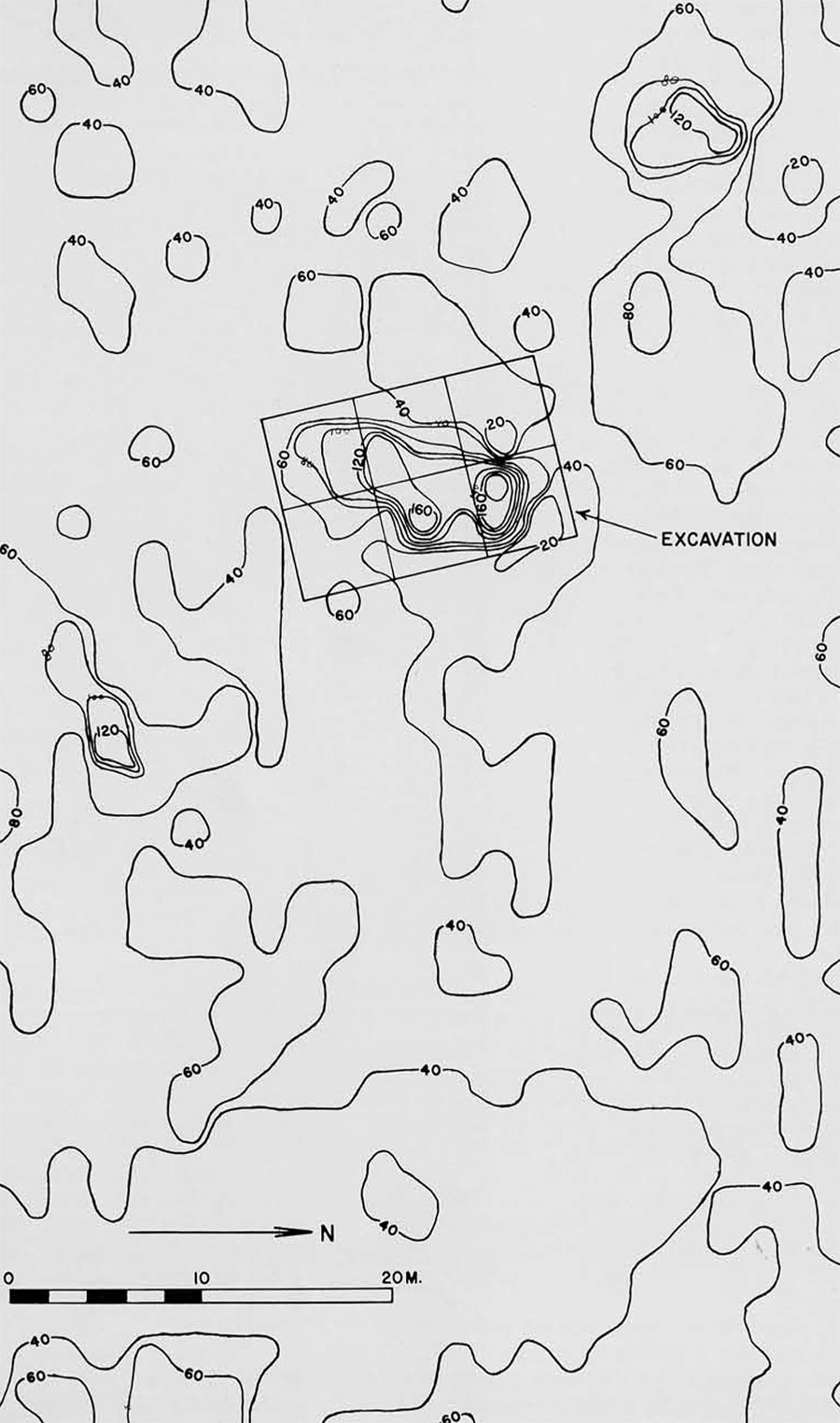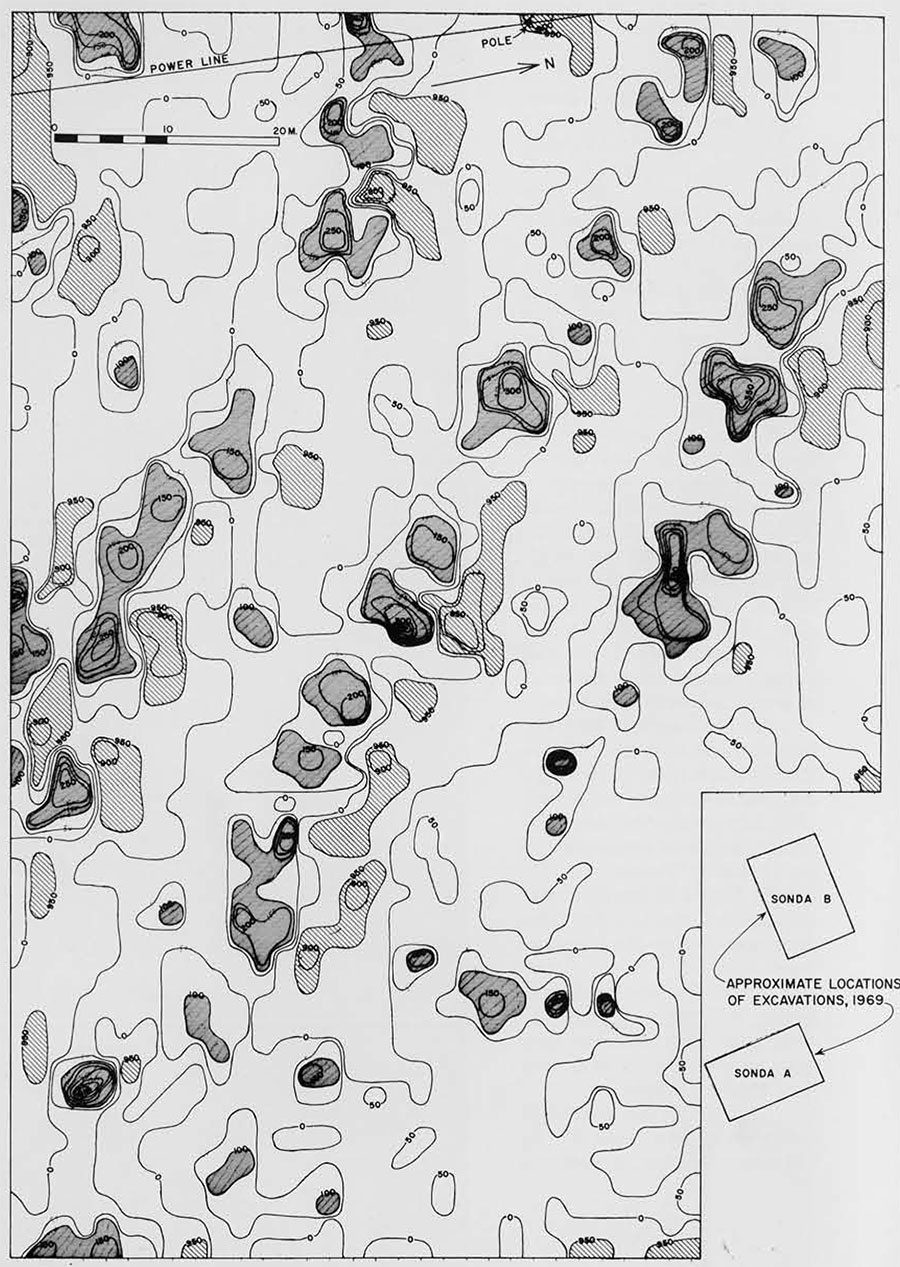 The first cesium magnetometer survey of prehistoric sites in Yugoslavia was carried out by Elizabeth K. Ralph in June 1969, on Neolithic sites being excavated under the joint direction of Drs. Alan McPherron, University of Pittsburgh, and Dragoslav Srejovic, University of Belgrade. Our aim was to see if the pattern of houses in a prehistoric village could be determined before digging. The results were spectacularly successful: we discovered whole rows of magnetic anomalies and testing by excavation confirmed that they were in fact house floors. The work shows that magnetometers are powerful tools in furthering the aims of modern archaeological research, even at sites as early as 4,000 B.C.
The first cesium magnetometer survey of prehistoric sites in Yugoslavia was carried out by Elizabeth K. Ralph in June 1969, on Neolithic sites being excavated under the joint direction of Drs. Alan McPherron, University of Pittsburgh, and Dragoslav Srejovic, University of Belgrade. Our aim was to see if the pattern of houses in a prehistoric village could be determined before digging. The results were spectacularly successful: we discovered whole rows of magnetic anomalies and testing by excavation confirmed that they were in fact house floors. The work shows that magnetometers are powerful tools in furthering the aims of modern archaeological research, even at sites as early as 4,000 B.C.
Neolithic cultures in Yugoslavia are well known among specialists because of their elegant ceramics and sophisticated human figurines. In Serbia, where the study was conducted, the earliest known Neolithic farming culture is called Starcevo and its painted pottery shows relationships with that of Greece and Bulgaria, areas through which the farming way of life, based on such domesticated foods and animals as wheat, barley, sheep, cattle, and pigs, was diffusing from its center of origin in the Near East. Radiocarbon dates indicate that Starcevo began around 5500 B.C. in the Serbian part of Yugoslavia. Around 4500 B.C., Starcevo, gave way to a Late Neolithic culture called Vinca. An apparently indigenous development, Vinca is one of a number of contemporary local cultures with distinctive styles of pottery and figurines, all of them seeming to indicate somewhat improved adaptations to the local environmental conditions of south and central Europe.
 Despite the fact that we know quite a bit about the pottery and other artifacts made by the Starcevo and Vinc\a peoples, we know very little about how they lived. Except for the systematic excavations carried out years ago by Vasic at the type-site of Vinca, a tell on the Danube near Belgrade, no site has been dug extensively enough to yield data on the nature of settlement —that is, on the spacial distribution of houses and other structures, storage facilities, and areas where specialized activities were carried out. Also, we know next to nothing about the reasons why particular spots were selected for settlement. Such information can be obtained only through large-scale excavation carried out with a high level of control, the ultimate aim of which is the complete uncovering of an entire settlement. Neolithic village sites suitable for settlement-pattern studies are densely distributed in the part of Yugoslavia south of Belgrade. Sites here are shallow, which minimizes the problems of keeping separate the superimposed levels that plague the digging of deeply stratified tells. One site in this area, Divostin, about 100 km. south of Belgrade and 10 km. west of Kragujevac, was selected for extensive and intensive investigations in a project organized by Drs. McPherron and Srejovic. Generous financial support was obtained—in local currency (Yugoslav dinars) from the Smithsonian Institution’s Foreign Currency Program, and in U. S. dollars from the National Science Foundation (Grant Nos. 8-0592 and GS-2218 respectively). Digging at Divostin began in September 1968 and continued for six months, with a break during the winter.
Despite the fact that we know quite a bit about the pottery and other artifacts made by the Starcevo and Vinc\a peoples, we know very little about how they lived. Except for the systematic excavations carried out years ago by Vasic at the type-site of Vinca, a tell on the Danube near Belgrade, no site has been dug extensively enough to yield data on the nature of settlement —that is, on the spacial distribution of houses and other structures, storage facilities, and areas where specialized activities were carried out. Also, we know next to nothing about the reasons why particular spots were selected for settlement. Such information can be obtained only through large-scale excavation carried out with a high level of control, the ultimate aim of which is the complete uncovering of an entire settlement. Neolithic village sites suitable for settlement-pattern studies are densely distributed in the part of Yugoslavia south of Belgrade. Sites here are shallow, which minimizes the problems of keeping separate the superimposed levels that plague the digging of deeply stratified tells. One site in this area, Divostin, about 100 km. south of Belgrade and 10 km. west of Kragujevac, was selected for extensive and intensive investigations in a project organized by Drs. McPherron and Srejovic. Generous financial support was obtained—in local currency (Yugoslav dinars) from the Smithsonian Institution’s Foreign Currency Program, and in U. S. dollars from the National Science Foundation (Grant Nos. 8-0592 and GS-2218 respectively). Digging at Divostin began in September 1968 and continued for six months, with a break during the winter.
Divostin, at the present time, is a small Serbian farming village, where the local people raise corn, wheat, tree fruits and other crops, and keep cattle, sheep, and pigs. They also distill and consume impressive quantities of the famous national drink schlivovits, a plum brandy. From the scatter of materials on the surface, the existence of a large Neolithic site underlying most of the contemporary houses and fields had been known for years and it was also known to have Starcevo and Vinca occupations that were a little different stylistically from one studied previously in central Serbia.

The excavations in 1968-69 soon revealed that while the Starcevo occupation was poorly preserved (for the most part only in the form of rubbish pits dug into the subsoil), the Vinca level was remarkably well preserved, with nearly intact house floors that appeared in the form of rectangles, up to 6 by 18 meters in plan, made of pounded earth and straw that had burned into a brick-red material like crumbly pottery. When the houses were burned—whether by accident or design is uncertain—the floors were rendered imperishable and were thus preserved along with what lay on them at the time of burning: baked clay hearths, packed-earth bins and work areas, pottery vessels, loom weights, milling stones, flint tools and flaking debris. The pottery yield from one house was over eighty reconstructible vessels, which is even more impressive if one considers that floors were encountered sometimes as little as 20 centimeters under the surface. Fortunately, the site had been plowed only superficially with ox-drawn plows. Had a modern tractor-drawn plow been used once, the site would have been destroyed.
House floors, found so well preserved, are important for a number of reasons. First, they make it easy to study the patterns of settlement on the site. Second, the distribution of materials in houses provides a remarkable record of the activities that were being performed at the time of burning. When comparisons from house to house are made, using modern multivariate statistical techniques performed on computers, inferences can be made about such non-material aspects of life on the site as the social units that existed, family life, and the organization of work. Similar studies have been carried out successfully for rooms in prehistoric pueblos of our Southwest. Third, archaeomagnetic dating can be applied to the fired floors and baked clay hearths, because their magnetic properties reflect parameters of the earth’s magnetic field at the time of burning.
The Yugoslavian Geomagnetic Institute, at Dr. McPherron’s request, brought a proton magnetometer to Divostin in October 1968, and we learned that the house floors and hearths were easy to detect with such instruments. The crew from the Institute surveyed a portion of the site and located a number of anomalies—areas with pronounced magnetic properties. In every case, when such anomalies were excavated, a house floor was found. Thus it appeared that magnetometer surveying could make it possible to map a whole site, at least as far as burned houses were concerned, before digging.

This successful survey made it obvious that it would be worthwhile to conduct more extensive magnetometer surveys at Divostin and at other Neolithic sites with similar burned house floors. Therefore, Dr. McPherron invited Miss Ralph to come in the spring of 1969 with the MASCA (Museum Applied Science Center for Archaeology) cesium magnetometers. The big advantage of these magnetometers is that, with them, areas can be covered much more rapidly. Also, though this was of little importance here, they are more sensitive.
Two types of cesium magnetometers, both manufactured by Varian Associates, were used. One utilizes the precision readout which was designed and built especially for MASCA for use in the search for Sybaris and has been described previously (Expedition, Vol. 7, No. 2, Winter, 1965). The other has a simplified audio readout. With this, the instrument crew can walk in lines at a fast pace and simply listen for anomalies. We used this to delineate the extent of anomalies at sites or, in their absence, to eliminate areas without anomalies very rapidly. After the preliminary audio exploration, we laid out grids in the areas of interest, to be covered in detail with the precision readout.

The site at Divostin was covered thoroughly in twelve grids insofar as ripening wheat fields and contemporary buildings permitted. In these grids, which covered 50,000 square meters, fifteen pronounced anomalies as well as many lesser ones were found. Three of the large anomalies were confirmed by excavation as being representative of burned Neolithic house floors. The large anomaly in grid No. 5 and the house floor revealed upon excavation are shown in the accompanying illustrations. In the photograph, one sees also a few smaller anomalies (the regions with closely spaced contours of equal magnetic intensity), but in this and in the other grids made at Divostin the anomalies are scattered, that is, they do not form any particular patterns.
At two pure Starcevo sites in the vicinity of Divostin, the magnetometer results were negative because of the absence of burned earth. However, at two other sites with Vinca occupations the results were in one case (Rajac) good, and in the other ( Grivac), downright spectacular.
Grivac, another site, like Divostin, with both Starcevo and Vinca components, is about 20 km. west of Divostin, and in June 1969, two test squares were excavated there under the auspices of the Divostin Project by Dr. Branko Gavela of the University of Belgrade, who had dug there some years before. His investigations produced corners of two burned Vinca houses, one in each square, at depths of about one meter and each with an even more massive layer of fired-earth floor than at Divostin.
Miss Ralph did a detailed survey of an area about 100 by 140 meters at Grivac, or perhaps a sixth of the whole site, as determined by rapid exploration with the audio readout. The drawing on this page shows the results of one grid. One sees a patterned and orderly disposition of anomalies that can be reasonably interpreted as parallel rows of houses on the basis of the Divostin work and the two excavated Grivac house floors. Such ordered rows of houses are even more impressive if one can extrapolate from the surveyed area to the entire site.

The situation at Divostin and at Grivac and possibly Rajac (not yet excavated) is certainly un-common, in that one would not expect every Neolithic site to have burned house floors in a good state of preservation, and it is clearly important that further magnetometer work coupled with excavation be done in the area. A number of questions arise immediately from inspection of the Grivac grids of anomalies:
(1) Does the system of parallel rows extend to the rest of the site?
(2) Does each anomaly actually represent a house?
(3) Are all houses identical in terms of size and function?
(4) Why are all the houses apparently burned here (there hardly seems room to fit in any hypothetical unburned ones on the map), whereas at Divostin this was not the case. Also some houses excavated at Divostin could be detected only when the subsoil was reached. Then, the foundation trenches for their walls were revealed by their different soil colors.
We hope that these questions can be answered by more extensive magnetometer work, especially at Grivac, followed by test excavations. Careful interpretation of anomalies, both large and small, may help to maximize the potentials provided by the powerful tool of magnetometer surveying while minimizing the biasing effect caused by the fact that magnetometers can detect only certain types of archaeological features.
